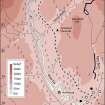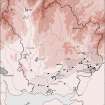Tarrasfoot Tileworks
Tile Works (19th Century) - (20th Century)
Site Name Tarrasfoot Tileworks
Classification Tile Works (19th Century) - (20th Century)
Alternative Name(s) Tarrasfoot Industrial Site; Tarras Tileworks; Buccleuch Estate
Canmore ID 67688
Site Number NY38SE 44
NGR NY 38066 80976
Datum OSGB36 - NGR
Permalink http://canmore.org.uk/site/67688
- Council Dumfries And Galloway
- Parish Canonbie
- Former Region Dumfries And Galloway
- Former District Annandale And Eskdale
- Former County Dumfries-shire
NY38SE 44 centred 38061 80952
Works (disused) [NAT]
OS (GIS) MasterMap, August 2009.
For flint knife found near tileworks, see NY38SE 19.
(Location cited as NY 381 809). Tarras Tileworks, early 19th century. A small works, with a single kiln and an L-shaped range of drying sheds. Closed in 1969 and used as a store.
J R Hume 1976.
The Tarrasfoot tileworks operated from c. 1900 to 1969. It is disused but remains complete, and has one intermittent kiln of Newcastle type.
G Douglas and M Oglethorpe 1993.
Main surviving buildings are; KILN: early 20th century; vaulted Newcastle kiln; rectangular-plan with openings to E and to W short walls; squat brick stack over common wall. Brick-built with iron/steel ties and braces. DRYING SHEDS: 2 single-storey buildings, the larger a remarkably long L-plan block, the other rectangular-plan; each structure is timber-framed with full-height louvred corrugated-iron panels; roofs half-slated. Interior with timber shelving racks. MACHINE WING: piend-roofed stone-built rectangular-plan block linked to long S wall of larger drying shed; machinery now removed. Roof full-slated.
Owned and formerly operated by Buccleuch estates for production of field drains. (Historic Scotland)
Field Visit (January 1981)
Tarrasfoot NY 380 809 NY38SE
This tileworks was in operation by 1857 but most of the present buildings are of more recent date. It was last used in 1969.
RCAHMS 1981, visited January 1981
(OS 6-inch map, Dumfriesshire, 1st ed., 1862, sheet liii; 2nd ed., 1900, sheet liii NE; Hume 1976, 95)
Field Visit (29 April 1993)
NY38SE 44 centred 380 809
The tile works at Tarrasfoot was established by the Duke of Buccleuch at the beginning of the 18th century, and provided draining tiles for his tenants. The tile works continued in production until the 1960's, producing mainly for the Buccleuch estate, but the kilns and drying sheds now lie abandoned.
Throughout its history, the tile works underwent several alterations and modifications. The map evidence shows that the kilns have been replaced on at least two occasions, and the clay pit has been enlarged and extended to the S. The brick-built kilns that survive on the site were built some time after 1899, and are classified as Newcastle kilns. Only one building appears to have remained unaltered, and this housed the processing plant. The 1st and 2nd editions (Dumfriesshire, sheet liii.4, 1859 and 1899 respectively) of the OS 25-inch map depict a tramway leading from the clay pit into this building
Visited by RCAHMS (ARW, SPH), 29 April 1993.
NMRS, MS/500/48/5.
Tarrasfoot. Listed as tileworks.
RCAHMS 1997.
Note (8 October 1997)
Locations of constituent elements: NW drying shed NY 3805 8096; SE drying shed NY 3807 8095; kiln NY 3806 8097
Information from RCAHMS (RJCM), 8 October 1997.










































































































